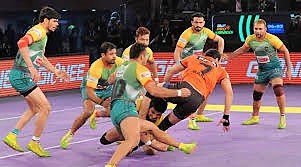Each country has a national game

Each country has a national game. The national game of English cricket, the baseball of the national game of the Americans. Our national game Hududu or Kabaddi; But in the end of time, the game is going to be lost. 10 years ago the school-based inter-school or the Thana Kabaddi competition was seen. It does not even look right now. Many people do not know the rules of the game Hadudu. As a national sport, it is necessary to know its history, heritage and rules. For home news readers, it is briefly given below:
Kabaddi is a popular game of the summer-countries of Asian continent. Especially in the Indian subcontinent it is an ancient game. The game was held in different sub-continent by different names. Since the regional game; So there was no statutory regulation. Kabaddi is the traditional name of the country's rural hoodoo Playing hoodoo was a source of entertainment till a while ago. Winners of the Hadudu contest were given a bullock, khasi, brass kalasi or gold-silver medal for a prize. It's a party game and there is nothing to spend in this game.
It is believed that in the prehistoric era, when the people learned to protect their own existence as well as to collect food and to protect themselves from the attack of wild animals, only the beginning of the kabaddi. Kabaddi is practiced throughout South Asia, but its origins are Punjab. Another idea about the origin of the kabadi is that the game is created with the idea of the attempted effort to penetrate the chakras in the Mahabharata.
Another idea about the origin of the Kabaddi game is that it starts at Tamil Nadu. It is found in the game of touching two children, although the hold of the breath is added later. In the Tamil area, the game is known as Kabaddi, Saduugi, Goodugudu, Palinjadungu and Sadugudatti. The term kabadi is most likely originated from Tamil Kai (hand) and PD (catch). This game was played in Kabadi in India and Pakistan, Hadudu in Bangladesh, Dudu in Nepal, Sri Lanka, Goodugudu, Thikab in Thailand and Chh. Goodo Goodu in Malaysia. The origin of the game is to attack individuals and groups by opposing party invasions and practicing the technique of counter-attack. The prerequisite to success in this game is the ability of physically and emotionally swiftly, muscular swiftness, lung power and tolerance, quick thinking and ability to take decisions, and the ability to apply and above all the opponent's strategy and attitude.
Kabaddi is an amazing game. There is no need to organize too much for this. Kabaddi can also be played on the open field, Indore, in school-college, in the house courtyard and even on one side of the house. However, the respected size of the kabaddi court is 12.5m by 10m for boys. And for women 11m by 8m .. There are 7 players in each team and at half time during the game Ÿ 20 minutes to 40 minutes A 5-minute break in the middle. A referee handles the game. Two umpires assist him There is one who calculates the point.
The National Kabaddi Federation was formed in India in 1950 to introduce the game in a unified manner. In 1953, this federation constituted the rules of playing Kabaddi. Some rules were amended and amended in 1960 by analyzing the trial for several years. In 1974, the first Kabaddi test was held in Bangladesh between India and Bangladesh. The Indian Kabaddi team won 5 Tests and won 4-1. The competition created huge enthusiasm in Bangladesh. Bangladeshi National Kabaddi team went to India in 1979 for a return test game.
In the meeting held at the guest house of Vilai Steel Mill in Madhya Pradesh, India's Ispatnagari, 1987, representatives from India and Nepal participated in the meeting. The Asian Kabaddi Federation was formed in that meeting. The first Asian Kabaddi championship was held in Calcutta in 1980, following the same formula. India, Bangladesh and Nepal participate in this competition. India are champions and Bangladesh runners-up.
After independence several federations were reconstituted for the development of sports in Bangladesh. In its continuation, Bangladesh Kabaddi Federation was formed in 1973. Indian National Kabaddi Tournament was held in Asansol, West Bengal in 1973. Kazi Anisur Rahman and Amir Hamza from Bangladesh went to Asansol to watch the competition. Since then, the rules of Indian Kabaddi play follow. Since 1974 national kabaddi competition has been held in Bangladesh. In 1980, Abdul Haq introduced training in kabaddi from India's NIS and introduced kabaddi techniques and regulations in # Bangladesh.
In the steady efforts of Bangladesh, the Kabaddi game was included as a regular event in the Safai Sports held in Dhaka in 1985. From then on, Kabaddi plays the international stage. The game was promoted to international status by incorporating a kabaddi game in the Asian Games held in Beijing in 1990. Since then kabaddi has been held in Asian Games as a regular event. Today the kabaddi game has become popular in some countries. Of these, India, Bangladesh, Pakistan, Sri Lanka, Nepal, Bhutan, Japan, Thailand, Iran, Malaysia and Korea are one of the largest.
The federation of these countries is making efforts to improve kabaddi. As a result, this game is becoming popular in countries such as Germany, UK, West Indies and Canada. Asian Olympic Council approved this game as a regular event
This post has received a 0.16 % upvote from @drotto thanks to: @mithujibon.
This post has received a 0.28 % upvote from @speedvoter thanks to: @mithujibon.